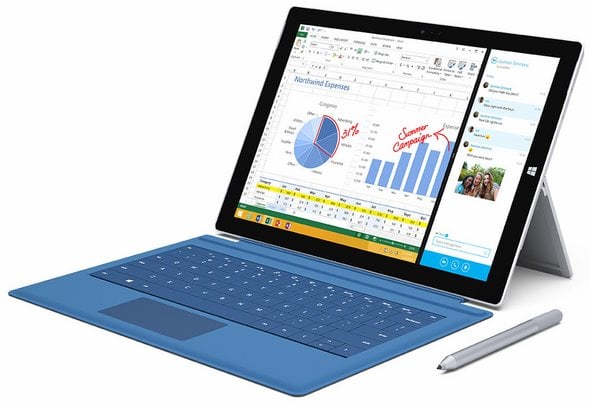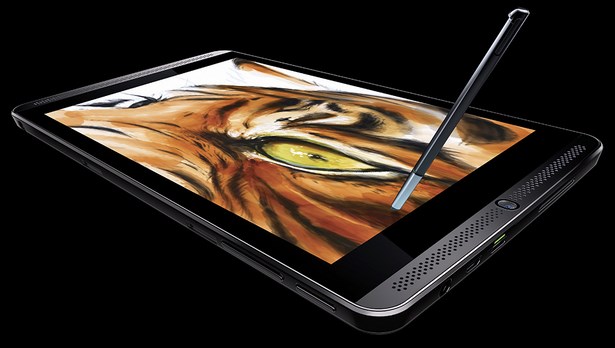HotHardware's 2014 Back To School Shopping Guide
The Samsung Galaxy Tab S is an all-around great performer with solid battery life that’ll get you through the most grueling of lectures. As far as flagship tablets are concerned, the Tab S 8.4 has all of the high-end features we’d expect, including a fast processor, plenty of RAM, expandable storage, and the latest version of Android. Samsung has also included various apps with the Galaxy Tab S 8.4 that add to its utility. Some of the great apps that are included with the Galaxy Tab S include SideSync 3.0, Multi Window, Kid Mode, Samsung’s new Papergarden, and Milk Music powered by Slacker. Thanks to its gorgeous high-resolution display, the Galaxy Tab S is also one of the few Android devices in the U.S. that offers Netflix HD.
By combining all of these features with a thin and light design that also looks great, Samsung has achieved a near perfect combination, which results in a very attractive flagship tablet. Of course, you’ll have to pay for all of this functionality. At $399.99 for the 8.4-inch Galaxy Tab S, however, the price is in line with what we’d expect from a tablet with bleeding edge hardware and innovative software features.
Microsoft Surface Pro 3: Starting Around $750
It’s the tablet that can replace your laptop if you want it to, which makes it ideal for educational use. The device's form factor and accessories make it somewhat different to work with than a standard laptop or more rigid convertible device, but Microsoft clearly has a tablet on their hands that can replace a laptop, for some users. With that said, we're hesitant to call the Surface Pro 3 a tablet. In our opinion, it is more accurate to classify the Surface Pro 3 as a convertible or 2-in-1 device, since it offers all of the performance and most of the features of a Haswell-based Ultrabook, but in a smaller form factor that requires the use of a snap-on keyboard to make it a truly productive device. If portability is your number one concern, pen input is appealing, and you'll use the device in tablet mode often, the Surface Pro 3 will likely serve you very well.
Microsoft has also nailed the user experience--everything the Surface Pro 3 was designed to do, it does well, and it is easily one of the more attractive portable devices we have used. However, if you're not a fan of Windows 8.1 and all that it entails, the Surface Pro 3 may not change your mind. We, however, think Windows 8.1 is ideal on a device of this type and think the Surface Pro 3 is a compelling, worthwhile update to the Surface line-up.
NVIDIA SHIELD Tablet: Starting Around $299
While studying is alright, clearly, you went to school to get your game on. If you’re looking to game while crisscrossing campus, this is your slate. One of NVIDIA’s stated goals with the SHIELD tablet was to build the best tablet for mobile gamers. But to do so, they first had to build a good general-purpose tablet. We think NVIDIA has pulled it off.
The build quality on the SHIELD tablet is top notch; the device is rigid, it looks great, and it feels good in the hand. The screen is also very good, the speakers sound great (for a tablet) and general usability is excellent. We understand why many tablet manufacturers customize Android on their devices, and dig some of the unique features available on other products, but we also like the clean, unmolested versions of Android NVIDIA puts out.
Lenovo ThinkPad 8 Windows 8.1 Tablet: Starting Around $399
This is yet another multifaceted tablet, but one that caters towards the serious/on-the-go crowd a bit more. The screen is bright and beautiful and sure, it can't game like quite and Nvidia SHIELD, but gaming isn't why you're primarily interested in this kind of device. You want Windows, and you want it to run smoothly, which it does on the ThinkPad 8. The 8MP camera takes quality photos and the QuickShot Cover's camera-activating trick is actually pretty useful.
What you'll want to weigh carefully is whether you're comfortable with the ThinkPad 8's battery life and whether you're willing to pay its higher price tag. At $399 ($499 for the unit we reviewed), the ThinkPad 8 is noticeably more expensive than the Dell Venue 8 Pro, for example. But the ThinkPad 8 has a higher resolution, among other differences, and that may be enough to put it over the the top. We will say this: if you go with the ThinkPad 8, get the cover, too.
Asus MeMO Pad 7: Starting Around $150
Fast, light, affordable, and useful. That’s the short list from this one, which is a great buy if you aren’t looking to break the bank. For one thing, the $150 tablet is remarkably sturdy, despite weighing only a little more than half a pound and being a mere 0.38 inches thick. It doesn’t look particularly flashy, but ASUS gives the device a little flair by offering it in multiple colors. And the screen, though not the best we’ve seen, is bright enough and responsive enough for most users.
There is no question that Intel has made strides with the Atom platform. The Bay Trail Z3745 is a good fit here: the ASUS MeMO Pad 7 provided solid benchmark scores and proved to be reasonably capable at gaming, which is where value tablets traditionally tank. Still, it’s disappointing to see only 1GB of memory, and the internal storage could really use a boost, especially considering that the OS and preloaded apps use some of that already light space.










